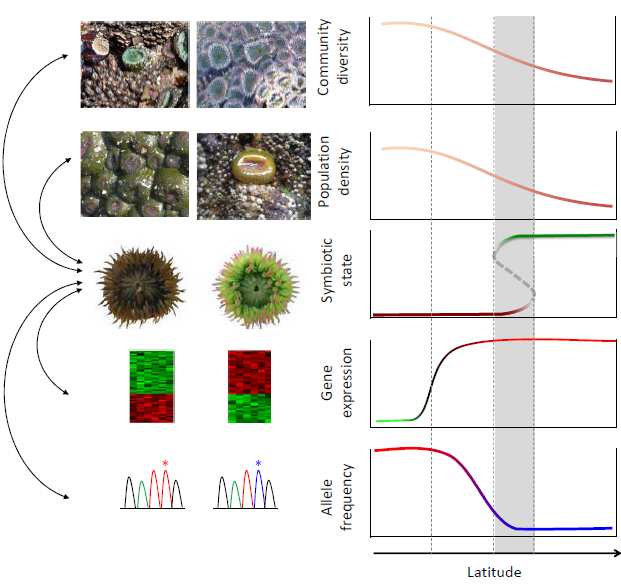Oregon State University
Systems Science in Marine Biology

Welcome to the Systems Science in Marine
Biology (SSiMBio) Home Page!
Systems Science in Marine Biology or SSIMBIO is a broad collaboration taking place at Oregon State University across multiple departments, involving 11 researchers and 6 graduate students. Our aim is to develop a systems-biology framework around the intertidal sea anemone Anthopleura elegantissima. By integrating datasets across disciplines, we hope to develop a complete picture of the biological responses that are associated in the system and particularly around the symbiotic state of this organism.
Climate change is driving rapid changes in the abiotic (non-living) conditions of coastal marine ecosystems, prompting extensive efforts to understand and predict its continued biological effects.
An Intertidal Relationship
Anthopleura elegantissima is a temperate sea anemone that lives on the West Coast of North America from Baja, Mexico to Seward, Alaska. This animal participates in a symbiotic relaitonship with two genera of microalgae, Symbiodinium muscatinei and Elliptochloris marina. These symbionts are housed intracellularly in host cells lining the gastrovascular cavity (their stomach) and provide additional nutrition to the anemone in return for CO2 and nutrients.
A Curious Creature
This Anthopleura is white because it has no algal symbionts. We call this aposymbiotic. One of the most intriguing aspects of Anthopleura's lifestyle is its ability to live with and without symbionts. SSiMBio is using a multi-dimensional and multi-level system science approach to learn about how and why Anthopleura occurs as it does.
occurring across multiple levels. This is the view of systems biology: a powerful framework for understanding how the processes occurring at some biological levels lead to predictable emergent properties at others. Studies focusing on a single level of biological organization frequently offer little predictive value, because their subjects – genes, organisms, or species – are embedded within complex systems of interacting factors. Gene products act within the cell’s biochemical environment, and organisms within the context of local environmental conditions. Predicting the responses of such systems following a perturbation such as climate change requires understanding the structure and dynamics of these systems. The growing field of systems biology aims to understand how interactions between different components lead to emergent properties of the systems. The systems approach is perhaps most well known from cancer research, where this approach has provided insights into the network of interacting signaling molecules that lead to inappropriate cell proliferation. While these studies have largely focused on interactions occurring at sub- cellular levels (i.e. proteins and nucleic acids), interactions occurring at larger scales (organism and species) are central factors shaping community structure and function, and are being disrupted by climate change. We believe that extending the systems approach to include these higher levels, and characterizing the structure and dynamics of these systems from genes to ecosystems, will greatly improve our understanding of biological responses to climate change in coastal marine habitats.
Indeed, there already exist myriad studies applying the traditional approaches of ecological, physiological, and molecular research to the study of climate change. However, these studies largely document pattern or test mechanism at only a single level in the biological hierarchy. We contend that a broader view is needed to make progress; a view that provides insight into the interactions and feedbacks

Allele
frequency
Gene
expression
Symbiotic
state
Population
density
Community
diversity


